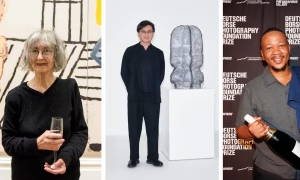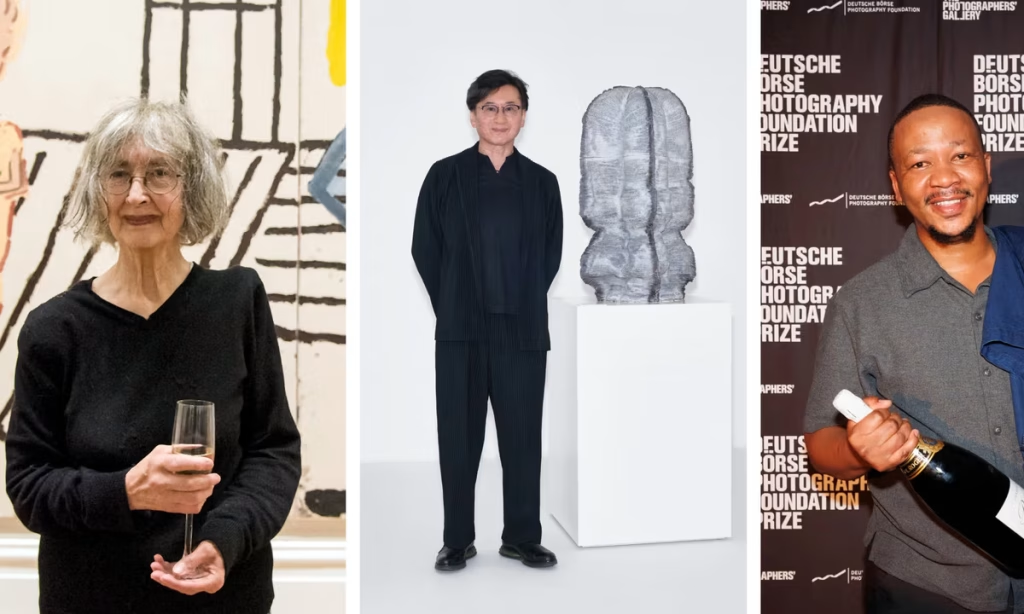Prior to the launch of the Turner Prize in 1984, the Tate had, according to Frances Morris, “languished on the sidelines of the contemporary scene for years”. The former director and curator of Tate Modern recalls how the award brought with it an immediate public profile, complete with heated critical debates and live television broadcasts that focused public attention on contemporary art and the museum itself. “The Turner Prize was a honey pot which attracted a growing younger audience and helped build an invaluable network of younger patrons,” she says. The Turner Prize is now 40 editions old and its draw has perhaps lessened a little.
But the art-prize system goes back at least a century: J.F. Archibald established a prize for portrait painting in Sydney in 1921. Earlier still, medals were handed out at salons in Paris from 1849 onwards. Then, as now, recognition was an important outcome for the winning artists, at best leading to acquisitions and exhibitions.
For many young artists, the instant cash is pretty useful, too; Samuel Ross, the British fashion and product designer and artist, won the CHF100,000 ($124,000) Hublot Design Prize in 2019, given to an outstanding emerging designer (the prize was last awarded in 2023). He spent it setting up his own independent company.
But winners beware: in some territories, including the UK and the US, if an artist has so much as sent in a jpg, and therefore applied to enter, tax could be payable on any winnings.
With many prizes run by luxury houses and major institutions, they certainly represent a perfect synthesis of marketing and philanthropy. But what really matters is what they do for artists themselves. We take a look.
John Moores Painting Prize
£25,000 awarded biannually to a UK-based artist working in a painted medium. Past winners include Graham Crowley (2023), Peter Doig (1993) and David Hockney (1967).
A successful businessman, and at one time among the richest men in England, John Moores struggled to find an audience for his own paintings. Frustrated, and believing his wealth counted against him being seen as an artist, he set up an art prize—and made its submissions process anonymous. Nearly 70 years on, the prize has become a barometer for changing tastes in painting and has been known to supercharge careers.
This was certainly the case for Rose Wylie, who won the prize in 2014 at the age of 80 (one of six women to receive the award). Within three years she had been made an OBE and joined the big-time gallery, David Zwirner. Next February she will become only the second British woman to have a major solo exhibition in the main galleries of the Royal Academy of Arts after Elisabeth Frink.
Loewe Foundation Craft Prize
€50,000 awarded annually to an international maker. Past winners include the ceramist Kunimasa Aoki (2025), the textile artist Fanglu Lin (2021) and the ceramist Jennifer Lee (2018).
The light of Loewe’s much-celebrated outgoing director Jonathan Anderson shone brightly on the Loewe Foundation Craft Prize until his departure for Dior earlier this year. Now its leadership is firmly in the hands of the foundation’s chief executive, Sheila Loewe. In 2025 she oversaw—as is the prize’s tradition—a glamorous ceremony, this time in Madrid.The film director Pedro Almodóvar delivered the Alex Brogden-designed silver trophy. Kunimasa Aoki’s work, created by compressing many thin coils of clay, one of 4,600 entries, was chosen as the winner from 30 finalists. “In countries like Korea and Japan, they tell me that they once dreamt of having a piece in a museum like the V&A,” Loewe told The Times earlier this year. “Now they dream of being part of the Loewe Foundation Craft Prize.”
Turner Prize
£25,000 awarded annually to one artist born in or working primarily in Britain. Past winners include Jasleen Kaur (2024), Jeremy Deller (2004) and Steve McQueen (1999).
Although not the most financially valuable, the Turner Prize is still considered the most influential award for UK artists. With the prize’s popularity, so too comes controversy. During her 2016 acceptance speech, Helen Marten memorably told an audience: “Everyone in this room is operating in this world that is so fucking privileged… I really hope [this] won’t change my life.” Meanwhile, Frances Morris recalls the handwritten postcard—in capital letters in black and red pencil—that she received from Richard Long, declining to accept his prize in person in 1989. “He preferred, in his words, to ‘go on a long walk’,” she remembers.
MacArthur Foundation Fellowship
$800,000 per person awarded annually to artists,scientists, teachers, and more. Last year’s recipients included Tony Cokes, Ebony G. Patterson and Wendy Red Star.
When the photographer LaToya Ruby Frazier became one of 24 recipients of the 2015 MacArthur Foundation Fellowship, she reflected: “When I realised I didn’t have any economic power, the only thing I knew to rely on was to document what was happening.”
Few awards could be said to alter this position like the so-called ‘genius grant’. Not only is the prize among the largest in the world, it is a famously no-strings-attached arrangement. MacArthur fellows are free to create as they see fit, without expectation or evaluation. The money is paid in instalments over five years.
Bianca Bondi’s Scrying in Astral Ponds (2023) is a Marcel Duchamp Prize nominee
Photo: Maru Serrano, courtesy of Semiose, Paris
Prix Marcel Duchamp
A €90,000 prize awarded annually to one visual artist of French nationality or residence. Past winners include Gaëlle Choisne (2024), Cyprien Gaillard (2010) and Tatiana Trouvé (2007).
The biggest art prize in France also gives its winners and shortlisted artists a three-month exhibition at the Centre Pompidou—or, while the space is closed for the next four years, at the Musée d’Art Moderne de Paris. As such, it is perhaps unsurprising that the judging process is a lengthy affair, something that is required by its founders, the Association for the International Diffusion of French Art (ADIAF).
A committee recommends a selection of artists who are eligible for the award, then ADIAF members will conduct nearly 60 studio visits. Once the list is down to the final four, each artist is represented to a jury by a rapporteur—such as a curator, creative director or art historian—chosen by the artist. Finally, a nine-person jury decides the winner. Nail-biting indeed.

Delivery Dancer’s Arc: Inverse (2024), by Ayoung Kim, who won the LG Guggenheim Award in 2025
Image: © the artist
LG Guggenheim Award
$100,000 awarded annually to an international artist working in technology-based art. Past winners include: Ayoung Kim (2025), Shu Lea Cheang (2024) and Stephanie Dinkins (2023).
Launched in 2022, it’s a new kid on the block, and its value is relevant to the costly nature of the technologies on which it focuses. As Noam Segal, a three-time juror and the LG Electronics associate curator at the Guggenheim points out, “none of us has the means to explore the vector space of AI in the way we could explore the internal mechanics of a digital camera”.
One of a growing number of prizes created in partnership with a well-known brand, Segal sees this collaboration as a vital part of an art ecosystem that is often lacking in support and public funding. “To me, it is a lifeblood of the art system,” she says.
Deutsche Börse Photography Foundation Prize
£30,000 awarded annually to an artist who has contributed to photography via a book or exhibition in Europe in the preceding year. Past winners include Lindokuhle Sobekwa (2025) and Adam Broomberg & Oliver Chanarin (2013).
Awards dedicated to one medium can struggle to cut through the noise, but not the Deutsche Börse Photography Foundation Prize which, for its size, packs outsized influence and notoriety.
By nominating image makers based on projects they’ve published or exhibited only during the previous year, it has created a fast-track method to picking winners who are enjoying pivotal career moments. Surely only in this prize do you see Arthur Jafa losing to Samuel Fosso (2023) or Sophie Calle to Dana Lixenburg (2017).
Chanel Next Prize
€100,00 prize per winner awarded biannually to ten international contemporary artists. Past winners include Tolia Astakhishvili (2024) and Precious Okoyoman (2021).
Founded in 2021 and judged most recently by the actor Tilda Swinton, the artist Cao Fei and the curator Hans Ulrich Obrist, this newcomer award is spendy and star-studded. Its sizable winnings are intended to support each artist in realising their most ambitious work—2024 winner Dalton Paula planned to use her €100,000 to construct a forest school—but it is also the mentorship (the Royal College of Art has participated) and partnership opportunities (Mubi) that make it desirable.
“Here we have the idea of the longue durée,” Obrist explains. “This is an example of something which is not just a one-off thing, but is a longer durational idea that is important in a world of short-termism.”
Praemium Imperiale winner Marina Abramović in Seven Deaths: The Snake (2020/21)
Photo: Osamu Nakamura
Praemium Imperiale
£77,000 awarded annually to one international practitioner in each of five categories: painting, sculpture, architecture, music and theatre/film. This year’s winners: Peter Doig, Marina Abramović, Anne Teresa de Keersmaeker, András Schiff and Eduardo Souto de Moura.
Given annually since 1989 under the patronage of Japan’s Imperial House, the full list of Praemium Imperiale winners reads like a who’s who of the art world’s most recognisable names. David Hockney and Willem de Kooning shared the inaugural award for painting, Richard Attenborough won the film/theatre category in 1998 and Zaha Hadid claimed the architecture prize in 2009. It’s considered to be the art world’s answer to the Nobel Prize.
But despite the fame of its winners—and its advisers, who include Hillary Clinton—it is not a Nobel rival. “We can see that every year a writer, for example, through the Nobel Prize, has visibility far beyond the field of literature,” Obrist says. “I’ve always wondered when this would exist also for the visual arts, so more global recognition for an artist would happen once a year as well.”
Dorothy & Lillian Gish Prize
$450,000 prize awarded annually to an international artist. Past winners include Thelma Golden (2025), Laurie Anderson (2007) and Frank Gehry (1994).
When Thelma Golden, the director and chief curator of Harlem’s Studio Museum, became the first institutional leader to win the prize in 2024, she told The New York Times, “I’m usually on the other side of this, someone who nominates artists for awards.” Nonetheless, in winning the prize, which was founded in 1994 and is administered by JPMorgan Chase Bank, Golden joined Nobel Prize winner Bob Dylan and Vicky Holt Takamine, a master hula teacher and native Hawaiian rights activist, on the list of esteemed awardees.
2024 Sobey Art Award winner Nico Williams
Photo: Cory Hulin
Sobey Art Award
C$100,000 awarded annually to a Canadian citizen or resident. Past winners include Nico Williams (2024), Laakkuluk Williamson Bathory (2021) and Jeremy Shaw (2016).
Canada’s most valuable art prize takes an interesting approach to broadening the scope of its winners. Each year the jury is composed of one representative from each of Canada’s six regions. They create a list of five artists from each region, and then a shortlist of six, with one finalist from each. Five receive C$25,000 each, with the winner getting C$100,000. In 2024, four out of the Sobey Awards’ six finalists were Indigenous Canadians, as was the prize’s winner, Nico Williams, who is known for his sculptural beadwork. “I want to send out the same message to all the bush kids out there,” he told Artforum. “We are doing it!”
Artes Mundi
£40,000 is awarded biannually to an international artist. Winners include Taloi Havini (2024) and Apichatpong Weerasethakul (2019).
In 2015, the winner Theaster Gates decided to split his £40,000 prize among the other eight shortlisted candidates after hearing other nominees discuss the importance and merit of art prizes, and what the money should be used for. He is thought to be the first artist to have made the revolutionary move. Artes Mundi was then split again in 2021, this time at the behest of judges and in recognition of the impact of the pandemic. The most recent winner, Taloi Havini, told The Guardian: “Artists don’t do it for the money, they do it for other things, but it enables an artist to keep going.”
Behula and a Thousand Tales, 2024, by Ashfika Rahman, who won last year’s Future Generation Art Prize, which is run by the PinchukArtCentre in Kyiv
Photo: Oleksandr Piliugin
Future Generation Art Prize
$60,000 cash prize, plus a $40,000 investment in practice awarded biannually to an artist aged 35 and under. Past winners include Ashfika Rahman (2024), Emilija Škarnulytė (2019) and Lynette Yiadom-Boakye (2012).
Run by Björn Geldhof, the creative director at award organiser PinchukArtCentre in Kyiv, the prize is free to enter, with no industry recommendation or invite needed. But it’s jury is top notch, most recently including Cecilia Alemani, the curator of the Venice Biennale in 2022, and Alicia Knock, a curator at the Centre Pompidou. “Every application really gets reviewed,” Geldhof tells The Art Newspaper.
“So sometimes an artist isn’t shortlisted but hears from a jury member who says ‘I saw your work. We want to work with you.’” It is this breadth of opportunity that really sets the prize apart—its 21-strong shortlist, five of whom receive $20,000, is surely the largest of any major award. This, Geldhof explains, makes it easier for the jury to take risks and combine recognisable and unknown artists. “It uplifts them,” he says, “in a very, very good way.”

